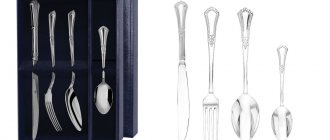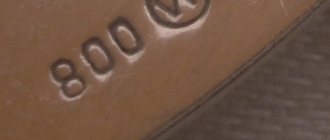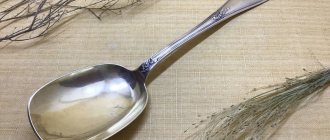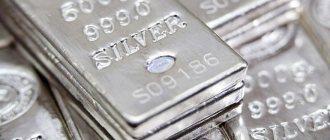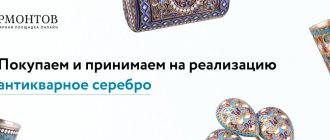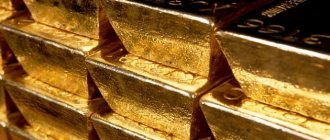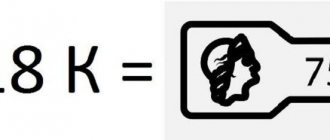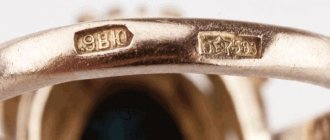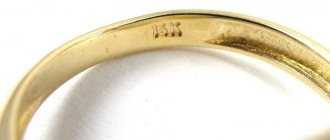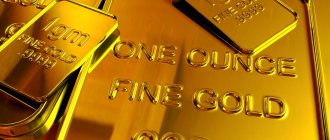Silver is the cheapest metal among those that have the right to be called precious. Silver jewelry can look elegant and noble, but be accessible to a wide range of consumers.
The situation with silverware is fundamentally different: it is not cheap, therefore a set of cutlery made from noble argentum is not available to every family. The explanation is simple: a lot of metal goes into making silver knives, spoons and forks, and production costs need to be recouped somehow.
The silverware's fineness, appearance, brand and history have a major impact on pricing. Let’s leave subjective characteristics aside and turn to the specifics, that is, the treasured numbers indicating the silver standard, and their immediate surroundings.
What are the hallmarks of silverware?
Silver is a soft metal, so its use in its pure form is limited only to the technical field and the production of measuring ingots.
In everyday life, we come across silver-based jewelry alloys: they are used to make jewelry, accessories, interior decor items and, of course, silverware.
To obtain an alloy with decent strength characteristics, so-called alloys, that is, jewelry alloys, are added to silver.
Moon metal's best friends are copper and nickel, but other additives are sometimes used. A large amount of copper determines the light yellowish tint inherent in silver “with history.”
The hallmark on cutlery is usually marked on the bottom of the handle, but variations are possible (especially on antique items). At the moment, on Russian products it reflects the content of precious metal per gram of jewelry alloy according to the generally accepted SI system. For example, 925 standard means that a kilogram of alloy contains 925 grams of silver (92.5%) - everything is simple and clear.
In Tsarist Russia, a different system of measures was adopted, the spool system, so on antique silverware you will see not three-, but two-digit numbers. The most common type is 84 sterling silver. This figure corresponds to the modern 875 sample.
By the way, almost all table silver of the Soviet era was produced from 875 alloy. Few could afford it, but the quality of these products was impeccable. Wealthy people, high-ranking officials and foreigners bought it with pleasure.
How does silverware differ from jewelry?
Table silver differs from jewelry only in the scope of application: similar alloys are used. Another thing is that for jewelry needs, high-grade alloys are more often used, while table silver can bear a mark with a modest number “800”.
The optimal jewelry alloy is the so-called “sterling silver”, 925 standard. It is used in the production of the vast majority of jewelry. But exclusive jewelry can also be of a higher standard, for example, with the “960” stamp.
The use of 925 silver in the production of cutlery is limited for obvious reasons. This alloy is quite soft, which promotes abrasion and deformation of products during operation. A fork with easily bending tines, you will agree, is not very convenient.
Cutlery set 4 pieces (go to SUNLIGHT catalog)
Nevertheless, the fairly soft 916 alloy is used to make very expensive tableware (decanters, glasses, shot glasses) and table decor items, usually with enameling. And 960 sterling silver is used exclusively for the manufacture of unique products with pronounced antiseptic properties.
However, with the advent of rhodium plating technology, the use of sterling silver in a not very familiar area has become more frequent. Now high-quality forks, spoons and knives are coated with a layer of rhodium by galvanization.
As a result of this treatment, the surface of silverware becomes more shiny, durable, and resistant to physical and chemical influences. And caring for rhodium-plated silverware is immeasurably easier.
Silver is a natural antiseptic that kills bacteria. However, rhodium plating, unfortunately, neutralizes its antiseptic properties. So if you want to feed your child with a silver spoon, it is better to choose untreated metal with the highest possible purity.
How to determine the authenticity of silver at home
There are several ways to verify authenticity. Let's look at them below.
Testing with reagents
In specialized stores you can purchase chemical reagents to test silver for authenticity at home. These include chrompic. The compositions are sold in glass or plastic bottles with an applicator.
The metal being tested is pre-cleaned, a drop of chromium is applied to the prepared surface and the reaction is observed. Excess solution should be removed with a cotton swab after 3–5 seconds. If the drop remains yellow and a colored spot does not appear on the product, it means that the alloy does not contain silver or the fineness is below 500.
If the color turns into red-brown, blood-red or dark brown with the formation of a precipitate, then the alloy contains silver of fineness higher than 500.
With the help of a chromium marker, with proper experience, you can determine the sample with an accuracy of up to 20 units.
But in order to determine for sure whether silver is real or not, it is necessary to carry out a test on a touchstone, using assay needles, as well as other reagents.
Determination of silver with a magnet
Many people wonder if silver is magnetic. Silver, like gold, is not attracted to a magnet. Therefore, in this way it is possible to weed out crude counterfeits made of steel, which is very similar to a silver alloy.
This diagnostic method cannot be called 100% reliable for two reasons. The first is that brass, for example, is also not magnetic. The second caveat is that when checking a silver chain, do not bring a strong magnet to the lock, because the clasp has a steel spring installed, and the real chain will be magnetized.
Sulfur ointment test
How to check silver for authenticity if there are no special reagents? A unique household indicator of a silver alloy is sulfur ointment, a cheap pharmaceutical product. The ointment is applied with a cotton swab to the product, a small area of which has been pre-treated with a soft nail file, and left for up to 10 minutes.
A silver item will leave a dark mark, while steel, brass and other alloys will not show marks. The stain is quite easy to remove with the same soft file.
Determination of density
Let's talk about how to distinguish silver from a fake by density. To do this, you will need accurate scales and a glass of water. First, calculate the mass of the sample. Then place a glass of water on the scale and drain it. Place the ring tied by a thread into the container so that it does not touch either the walls or the bottom. We divide the result of the previous weighing by the resulting value and find out the density of the product, and then compare it using the table.
Table of theoretical densities of metals:
| Metal | Density (g/cm3) |
| silver 960 | 10,43 |
| silver 925 | 10,36 |
| silver 900 | 10,32 |
| silver 875 | 10,28 |
| silver 800 | 10,15 |
| silver 750 | 10,06 |
| brass | 8,3–8,7 |
| steel | 7,8 |
| aluminum | 2,70 |
The disadvantages of this method are obvious: it is quite labor-intensive; products with stones and hidden voids, as well as chain products and household items made of silver cannot be tested in this way.
Determination of silver by thermal conductivity
Real silver has the highest thermal conductivity coefficient among other metals. Heating of the silver product occurs faster. A test with silver and cupronickel spoons is indicative: if you hold them in your hands, the first one will heat up faster.
Non-working methods
On the Internet you can find tips for determining the authenticity of silver using a piece of chalk or white paper: you need to run a ring, cross, pendant or coin over the surface of these materials. They say that real silver will leave a black streak. Indeed, the stripe will remain, but this is due to contamination on the surface of the metal, which can be either noble or base.
What do the silver marks on spoons mean?
Silver is an inexpensive, but still noble metal. This means that it is subject to mandatory branding. For silver in Russia, a stamp in the shape of a lying barrel is accepted. In addition to the number indicating the content of precious metal, there is a female profile wearing a traditional Russian kokoshnik.
In addition to the mandatory hallmark, other marks may be affixed to the metal. Usually these are logos of manufacturers, brands, brands.
It is extremely difficult to understand all this diversity, and even more so if we are talking about antiques. The best option in this case is to submit the product for professional examination. The expert will indicate not only the precious metal content, weight and origin of the product, but also its estimated value.
You can, of course, experiment with homemade methods of determining the precious metal (iodine, lapis pencil, sulfur ointment and others like them), but no one can guarantee an accurate result. And there is also the risk of spoiling a valuable item: what if you received a spoon made at the Savva Morozov manufactory especially for the royal family?
Silverware produced in other countries bears the mark accepted in the country of origin. And in the Soviet Union, products made from precious metals were, as expected, decorated with a five-pointed star with a coat of arms in the center.
Pros and cons of branded spoons
To determine the necessity and rationality of using this type of cookware, you need to consider its positive and negative aspects.
Spoons with a stamp.
Read also: The most toxic couples of zodiac signs
The advantages are:
- quite affordable price with good external characteristics;
- Possibility of use in hot containers due to low thermal conductivity;
- strength and wear resistance.
For a long time there was talk about the dangers of this type of dishes for health. But this fact is not entirely true. Copper does release toxins when it comes into contact with hot foods. But tableware created in compliance with all the rules will not cause harm.
Markings on silver spoons
Silver markings vary from manufacturer to manufacturer, but an hallmark is required. However, confusion may arise: for example, in the old days, the hallmark was set not only on silver, but also on silver-plated products.
And there are simply too many alloys similar to silver to count! If products made from them were produced in the Soviet Union or Russia, they will also be stamped (of course, without the coveted numbers):
- AL – aluminum;
- MELCH – cupronickel, an alloy of copper and nickel;
- MNC – nickel silver, copper and nickel plus zinc;
- MN – monel, cupronickel with a high nickel content;
- STAINLESS – “stainless steel”, that is, stainless steel.
Naturally, such cutlery is not silver and does not represent much value.
Russian Federation
Soviet standards were in effect until 1994. The young state experienced a change in stigma. The image of a woman in a kokoshnik, turned to the right, returned to him. The code of the assay inspection, as in the USSR, is marked with a Russian letter. Currently, the following six hallmarks can be seen on silver items:
- 800;
- 830;
- 875;
- 925;
- 960;
- 999.
The most common items I have seen are 925 sterling silver. As soon as I get my hands on something made of a precious metal, I immediately look for a hallmark with its hallmark. 999 silver is considered pure metal. Silver itself is very soft and easily deformed.
Famous world manufacturers of silverware
Antique silver is the most valued item: its value increases every year. Rare silver from famous manufacturers of the past has the highest cultural and historical value and is sold mainly in antique stores or at auctions.
Nevertheless, even now you can buy luxurious silverware from both Russian (Veliky Ustyug, the famous Argenta, Kostroma Jewelry Factory) and foreign (British Royal Buckingham, German Robbe & Berking and Koch & Bergfeld) manufacturers. Yes, it’s not cheap, but it’s a smart investment: luxury silverware will only become more expensive from year to year!
18.08.21
History of silver hallmarking
A mark on a precious metal can be compared to a passport of a resident of a country. It is the stamps that allow you to obtain complete reliable information about the composition and quality of the metal. Ancient silver jewelry imported into the territory of Tsarist Russia was subject to mandatory branding, thanks to which it was possible to determine the marking of the master or manufacturer.
The hallmarking system was first introduced by the English King Edward I. According to the introduced standard, the share of silver in the alloy should not be lower than 92.5%; fulfillment of this requirement allowed the silver to bear the title of “sterling” and gave the right to receive a hallmark with the head of a leopard.
The master's mark was introduced in 1363, which significantly reduced the number of counterfeits. In 1478, a letter indicating the year was added; in 1544, the standard was supplemented with a walking lion, confirming royal control. This system is recognized as the main one in England.
Assay marks contained information about the city in which the purity of the silver was tested. Since 1478, the assayers, who tested and hallmarked silver, were obliged to perform their functions in the building of the Guild of Goldsmiths. London is the first English hallmarking center, although at first it did not have an hallmark. It was not until 1544 that the leopard's head, a hallmark of sterling silver, was recognized as the hallmark of the London Assay Office. At the end of the 17th century, other assay offices were established, which had their own hallmarks: Chester - three sheaves of wheat and a sword; Exeter - castle with towers; Birmingham - anchor; Newcastle - three castles and Sheffield - a crown.
The times of the Civil War, which took place in England from 1649 to 1660, made adjustments to the silver hallmarking system. Sterling silver was melted down into coins that were used to pay soldiers. After the restoration of the monarchy, when Charles II assumed the throne, the demand for household silver increased so much that coins were melted down to produce the required quantity of household utensils. All of the above actions were carried out illegally; to eliminate this practice, the British standard was introduced in 1697, which assumed the presence of 95.8% pure precious metal. The system was monitored by new marks. The walking lion was replaced by the figure of a woman, personifying Britain, and the lion's head was replaced by the head of a leopard wearing a crown. The sterling standard was re-adopted in 1720.
The silver tax was first levied in England in 1720. The decision to introduce a new tax was provoked by the fact that England's expenses during the American War of Independence increased several times and required financial tax support. In 1784, the stamp depicted the profile of the monarch, which confirmed the fact of payment of the tax. Profiles of monarchs were stamped on English silver until the end of the 19th century; silversmiths achieved the abolition of the tax in 1890.
A number of optional hallmarks include commemorative hallmarks, including the Golden Jubilee of Queen Mary and George V, the Coronation of Elizabeth II and the Silver Jubilee.
How to choose the right silver product
Pay attention to color and weight: Ag is a fairly heavy metal, white. The more copper, the closer the shade to red. In addition, 925 grade jewelry reacts less well to magnets than jewelry with a lower Ag content. Silver plated jewelry will be marked "MET".
Silver jewelry
